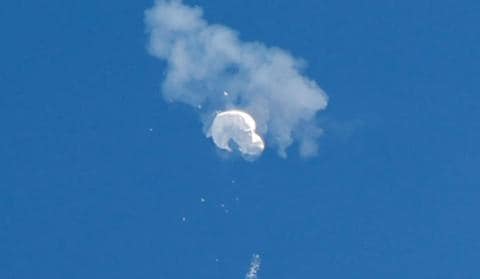On February 10, 2023, the Chinese think tank Internet of Things published an article titled "Did the U.S. Spend $400,000 Shooting Down the Civilian Balloon in Order to Crack China's Key Air Technology?"[1] The article provides an overview of the Chinese spy balloon saga, echoing Chinese government narratives about the balloon’s civilian research mission, and it asserts that the U.S. violated international law by shooting down a civilian aircraft that entered its airspace "in distress" due to force majeure. In addition, the article suggests that the U.S. government is refusing to return the debris from the balloon to China because it wants to analyze "key" Chinese technologies on it. It also provides information about advanced Chinese airship technologies that are in development and points out that the U.S. spent at least $400,000 to shoot down the "wandering balloon.". Following are excerpts from the article:

The U.S.'s Downing Of The Balloon Whose "Fanciful Drift Has Caused Such Uproar" Was "A Clear Violation Of The Convention on International Civil Aviation"
"It has been a week since an unmanned Chinese airship strayed into U.S. airspace. According to the latest information, the United States sent its most advanced F-22 Raptor fighter jets to shoot down the balloon and said that it refused to return the balloon's debris and equipment to China. Despite China's repeated claims that the unmanned civilian airship's straying into U.S. airspace was an accident of force majeure, the U.S. overreacted by sticking to its 'Chinese conspiracy' theory, calling it a 'spy balloon' used to spy on U.S strategic sites, and it overreacted by shooting it down. This act is a clear violation of the Convention on International Civil Aviation (Chicago Convention).
"Why is the United States so worried about a 'balloon' whose fanciful drift has caused such uproar? Why did the U.S. refuse to return the equipment after shooting down the balloon? Senate Majority Leader Chuck Schumer (D) has said that the United States can collect the equipment and analyze the technology used by the Chinese military. What is the key technology that the U.S. is trying to find out from this balloon, after all the unreasonable technological restrictions it has imposed on China?
"The U.S. Put On A One-Man Show With The Wandering Balloon
"Over the past week, the case of the 'Wandering Balloon' has attracted a lot of attention in the United States. On February 2, Pentagon spokesman Patrick Ryder said that the U.S. government had detected and was tracking a high-altitude surveillance balloon that has been flying over the continental U.S. for several days. U.S. media reported that the balloon even came close to top-secret U.S. nuclear missile bases.
"The next day, a spokesperson from China's Foreign Ministry responded: 'The airship is from China. It is a civilian airship used for research purposes, primarily meteorological. Affected by the Westerlies and with limited self-steering capability, the airship deviated far from its planned course.'
"Eventually, the United States sent in its most advanced F-22 Raptor fighter jet and fired an AIM-9X Sidewinder air-to-air missile to shoot down the balloon. In response to this action, Tan Kefei, China's Ministry of National Defense spokesman, once again stated on February 5, through an official ministry account on WeChat, that this is a civilian scientific research balloon that is mainly for meteorological research.
"The U.S. military attack on our unmanned civilian airship is a clear overreaction. On the afternoon of February 7, Charge d'affaires Xu Xueyuan of the Chinese Embassy in the United States was ordered to lodge solemn representations with senior officials of the U.S. State Department and the White House National Security Council over the U.S. attack on a Chinese unmanned civilian airship.
SUPPORT OUR WORK

"John Kirby, a spokesman for the U.S. National Security Council, said that the U.S. had no plans to return pieces of the balloon or its equipment to China. In response, Chinese Foreign Ministry spokesperson Mao Ning said, 'The airship does not belong to the U.S. It belongs to China.' She also said that the Chinese government will continue to resolutely safeguard its legitimate and lawful rights and interests.
"In fact, if the airship had not deviated significantly from its intended course, there would have been no need to enter the United States. After completing its civilian mission, the balloon would either send information back home via satellite or drop its payload on a planned route to a point in the ocean for recovery. The balloon itself would eventually descend and sink into the sea.
"We don't know exactly why the U.S. has taken these steps. Zhu Feng, dean of the School of International Studies at Nanjing University, said the balloon incident highlighted the long-term lack of mutual trust between China and the US, and that anti-China sentiment in the U.S. has kidnapped Sino-U.S. relations, which will make it harder to effectively manage bilateral relations.
"The Meteorological Research Blimp Was Innocent
"Now back to the subject of the event, the unmanned airship. At present, there is no further information about the unmanned weather airship shot down by the United States, except that it is measured to be about 30-40 meters in diameter and flying at an altitude of 20 kilometers. Photos posted online show the unmanned airship in the shape of a sphere, with a pod that consists mainly of engines, propulsion and fins, and no human cabin. Videos of the airship being shot down shows it quickly deflating and turning into a 'line' – it is presumably a soft airship or a tethered balloon without an internal frame.
"Photos of the Chinese balloon released by the U.S. show that the balloon has solar panels, which may be used to power the equipment on board – a common way for large balloons to be powered. But the unmanned airship was spherical rather than streamlined for flight, and it does not have a large propulsion system or directional control system, which means it mainly drifts with high-altitude air currents and has limited ability to maneuver.
"In addition, according to relevant meteorological reports, Earth has multiple atmospheric circulations due to the uneven heating of the sun and the deflection force exerted by its rotation on the moving air currents. It is not impossible that a balloon could travel from Asia to America in a particular season. This also proves from one aspect that the action of the United States to shoot down the airship is not only an overreaction, but also a serious violation of relevant international convention.
"According to the Convention on International Civil Aviation (Chicago Convention), Chinese civilian unmanned airships enjoy the right of distress entry into foreign airspace, including the United States – that is, they may enter foreign airspace without prior notice when affected by force majeure such as weather. Under the convention, states must also refrain from the use of force against civilian aircrafts in flight. Therefore, the United States should have taken assistance measures to the Chinese civilian aircraft, which was in distress. The use of military force by the United States to attack the civilian airship obviously exceeds the necessary and reasonable limits and violates the rules of international law.
"In addition, instead of taking matters into its own hands by shooting down the airship and removing the wreckage, the U.S. should allow China to assign observers to participate in the investigation of the accident and inform China of the findings in a timely manner. Any measures taken by the United States should respect the various ownership rights of the relevant Chinese enterprises owning the airship. One international law expert has said that if the U.S. cannot prove that the blimp poses a military or related threat, China has the right to demand compensation.
"In fact, weather sounding balloons – unmanned airships used for weather work – are often mistaken for UFOs. A sounding balloon is the carrier of the whole sounding equipment. It carries a radiosonde to the high altitude at the speed of 6-8m/s to detect high altitude meteorological elements...
"The Technological Battle Behind the Unmanned Airship
"Since the U.S. shot down the sounding balloon, there has been much speculation about the identity of the maker of the high-profile unmanned airship. While the exact company that made the airship is yet to be determined, there is no doubt that there is a group of domestic companies capable of building unmanned airships for civilian use. In addition to the well-known company DJI, other companies such as EHang, Zhuzhou Rubber Design and Research Institute, and Parrot are all strong in this field.
"Xu Shunli, the general manager of the Shanghai-based Datian Airship company, said that at present, the domestic sounding balloon is in a R&D stage and has not yet entered the stage of industrialization. In the future, there will be two major development directions for aerostats such as airships. One will be stratospheric airships, and the second will be heavy-duty airships, suitable for unconventional transportation of extremely long, large, or heavy objects. Among these, a stratospheric unmanned airship is a major scientific research project being promoted by China, but no countries in the world have successfully developed and put into official use.
"With the rapid development of solar energy, batteries and artificial intelligence technologies, the design of unmanned stratospheric airships has become possible.
"In terms of domestic research progress, China's self-developed stratospheric Yuan Meng airship made its first test flight in December 2015. According to reports, stratospheric airships can be widely used in land and resources observation, marine monitoring, environmental protection, disaster prevention and reduction, fine agriculture, water conservancy monitoring, geodetic mapping, urban planning and management and other aspects. Stratospheric airships will play an important role in promoting the coordinated regional development, coordinating the development of urban and rural areas, promoting the construction of new socialist countryside, strengthening the conservation of energy and resources and the protection of ecological environment, enhancing the ability of sustainable development, and optimizing the pattern of land development. It is of great significance for promoting the overall development of national economy.
"In terms of international research progress, foreign media has reported that Sceye, a private company in the United States, previously announced the news of stratospheric airship manufacturing. The company chose New Mexico as its stratospheric flight base in the United States for observation of Earth and for communication. Stratospheric Airships HAPS (High Altitude Platform Stations) developed by Sceye are known to be capable of staying at altitudes of nearly 20,000 meters for long periods of about 65 days, and they can be used to monitor crop conditions, climate change, and personnel transport. Notably, the airship could also improve communication links between drones, aircrafts and satellites, as well as extend broadband.
"Final Words
"Notably, the unmanned Chinese airship was shot down by an AIM-9X missile fired by two U.S. F-22 fighters only after it had descended to an altitude of 20,000 meters. The F-22, known as the world's strongest fifth-generation stealth fighter, has been in service for more than 20 years without a combat record. However, it shot down a Chinese airship at an altitude of 19,800 meters this time, creating the highest altitude record of the U.S. military ever shot down an aircraft.
"Media reports said that while the U.S. military claimed that its fighter shot down the Chinese airship with only one missile, local witnesses said that the F22 fighter jets fired two or three AIM-9X missiles before the last one successfully hit the target. It is also said that the cost of this type of missile launched by the F-22 is 400,000 dollars per missile. Some Chinese netizens called the U.S. a 'loser.' But while there are no exact numbers, China's unmanned airship will certainly not be cheap. There is no point in comparing costs here."
[1] Iot101.com/mobile/news/6754.html , February 10, 2023.




